The Big Book of Pain: Torture & Punishment Through History (34 page)
Read The Big Book of Pain: Torture & Punishment Through History Online
Authors: Daniel Diehl
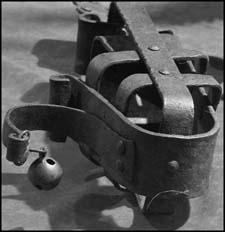
A version of the boot.
BREAKING ON THE WHEEL
The wheel in question might be no more than a standard wheel taken from an oxcart or wagon, or it might be as elaborate as a custom-made device resembling a wheel mounted on a low pole (or axle) permanently set into the ground in such a manner that the wheel and support pole looked like a circular picnic table. To this wheel, those condemned to an especially brutal death were tied in a spread-eagle position. In front of a cheering crowd the executioner proceeded to inflict as many varying painful tortures as possible until the victim died. Common among the tortures used on the wheel were having great pieces of flesh ripped from the body with plier-like pincers (sometimes heated red-hot), having every joint and limb shattered with iron bars or wooden mallets and having the hands, feet, arms and legs lopped off with axes. As life ebbed from the victim and the spectacle seemed nearly over, the executioner would strike off the poor wretch’s head. A particularly elaborate variation on the wheel used by the Romans involved a wide, drum-like wheel mounted about 1ft above the ground on an ‘A’ frame, so as to resemble a Ferris wheel. The outside of the wheel was set with multiple spikes and it was to the face of these that the victim was tied. Beneath the wheel, mounted into the ground was a second set of spikes. When the wheel was turned the victim was ground to pieces between the two sets of spikes.
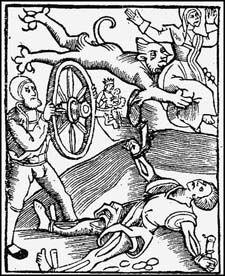
The wheel.
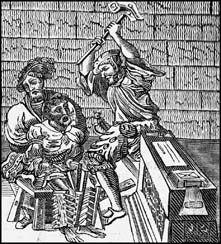
Brodequins.
BRODEQUIN
Used primarily by the French, the
brodequin
was a shallow, three-sided box, or trough, made to fit snugly enough around a man’s legs so that the legs were compressed tightly together. When the legs were in place they were securely bound with ropes. Next, wooden wedges were driven between the victim’s knees and ankle balls, shattering the delicate bone ends. Additional wedges were often driven directly into the soft tissue of the thighs and around the shins.
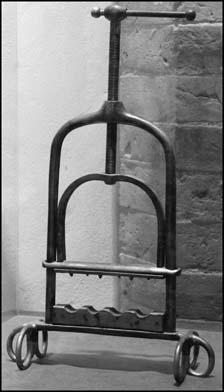
Finger pillory.
PILLIWINCKES
A uniquely Scottish device, the pilliwinckes (alternatively spelled pilliwinks) were a device for crushing the fingers not unlike the thumb screws (see p.179). Whatever their precise appearance, written descriptions indicate that they caused the fingers of one hand to be bent palm-ward from the rear-most joint where they were held in a flat position while the device was slowly tightened to the point where the fingers were crushed. Whatever their exact nature, they were universally described as ‘a grievous torture’.
PRESSING
Pressing was used specifically as a method to force reluctant suspects into confessing their crimes. Under medieval and later law, a full confession was necessary before the government could confiscate the property of the convicted party. Without such a confession the suspect’s personal property would remain in the family even if the party in question was found guilty. To help ensure a confession, the slow and painful torture of pressing was instituted. According to the official act:

Finger screws.
the prisoner shall be remanded to the place from whence he came, and put in some low, dark room; there he shall lie without any litter or anything under him, and that one arm shall be drawn to one quarter of the room with a cord, and the other to another, and that his feet shall be used in the same manner, and that as many weights shall be laid on him as he can bear, and more. That he shall have no sustenance but the worst bread and water, and that he shall not eat the same day on which he drinks, not drink on the same day on which he eats; and so he shall continue till he die.
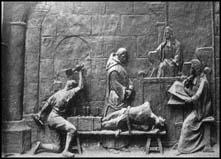
A version of the brodequin.
Obviously the point was to make the poor wretch talk long before he expired, but in some instances the accused held out until their ribs were crushed. Such was the case of Margaret Clitheroe who, in 1586, was accused of providing sanctuary for a Jesuit priest. After a quarter of an hour of pressing, during which time nearly 900lbs were piled on her, Clitheroe’s ribs literally exploded through her sides. Another case where the victim held out until his body was crushed under the weight took place during the Salem Witch Trials of 1692 when Giles Corey was pressed to death for refusing to confess that he was a witch. In a slower, more prolonged pressing, in 1776 Thomas Spiggot endured more than a week of daily increased weights. In his delirium Spiggot believed his head was being crushed but, in truth, it was only the increased blood pressure that caused the pain in his head. Finally, after a total of 400lbs had been piled on top of the door laid on Spiggot’s back, he agreed to confess. In India a variation on pressing involved tying two stout bamboo poles to the front and back of a victim’s chest and then, usually with the aid of ropes, pulling them tighter and tighter until the ribs were crushed. In this instance the purpose of the exercise was not to make the victim confess but to maim them so horribly that they were assured of a slow, agonising death.

The wheel.
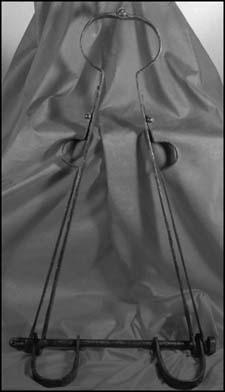
Scavenger’s daughter.
SCAVENGER’S DAUGHTER
Named for its inventor, Leonard Skeffington (whose name was later corrupted to ‘scavenger’), Lieutenant of the Tower of London during the reign of Henry VIII, the scavenger’s daughter was a torture device made of iron bars that had been roughly formed into an ‘A’ shape with a loop at the top large enough to be locked around a man’s neck, two loops at the mid-point (approximately where the cross-bar of the A would be) manacled the wrists and two more loops as the lower ends of the A, into which the victim’s knees could be locked. The device was short enough that the body had to be bent forward far beyond its normal limits – usually by having the torture master’s assistant straddling the victim and pressing down on his shoulders – before a man could be locked into it. The chest was forced to the knees and the stomach to the thighs until the victim was virtually doubled into a ball. The unnatural extension of the spine caused blood to gush from the victim’s ears, nose and mouth. If left on for more than a few minutes the scavenger’s daughter could permanently dislocate the spine and fracture the breast bone and ribs. Alternatively called Skevington’s Gyves, the Iron Shackle, the Spanish A-frame and the Stork, there are only a very few accounts of this device ever being used. A make-shift variation on the Scavenger’s Daughter was employed by Britain’s Royal Navy where it was referred to as ‘Tying Neck and Heels’. In this procedure, the victim would have one musket laid across his shoulders and another placed beneath his knees. The two guns were then pulled towards each other with the aid of ropes and several strong sailors. The damage was nearly identical to that inflicted by the Scavenger’s Daughter.